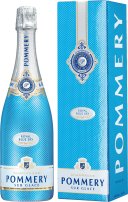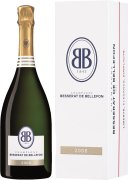Bollinger Rosé
The House of Bollinger has been producing fine wines of Champagne since 1829. In the last 180 or so years they have built a reputation of the highest standard. Rich and subtle with a pleasant nose and flavours that come back begging you for more, this is one of the finest non vintage Rosé Champagnes.
Pommery Cuvée Louise half
Created in homage to Louise Pommery, daughter of Madame Pommery, Cuvée Louise is a wine of exceptional and absolute purity which expresses the quintessence of the knowhow of the Maison Pommery.Cuvée Louise finds its origin within three grands crus; Avize, Cramant and Aÿ - true gems of the Champagne region.The 2006 vintage, uniquely available in half bottle size, expresses all its lightness and delicacy with subtle minerality. The harmony is perfect. Aromas of white flowers are wonderfully associated with hints of prunes and white peaches, creating a silky and fine effect. It embraces the palate with grace and elegance, the finale is long and tense.
Pommery Royal Blue Sky Non-Vintage
Pommery Blue Sky - another way to think Champagne! The fruit of a new Pommery experience with a traditional blend. A Champagne that opens up towards a happy moment. An intense savour which will surprise first of all through its richness before freeing an invigorating freshness. At first we perceive notes of dry figs and dried almonds. Then we find touches of almond paste, millefeuille, marshmallow and honey. All these flavours blend with simplicity and elegance with lemony and dried orange notes and several hints of spices.A Champagne designed to pour in a large glass and over ice (+/_ 5 ice cubes). To be enjoyed on its own or perfectly paired with dessert.
Laherte Frères Brut Champagne Non-Vintage
The distinctive, geologically complex terroir of Chavot and the Coteaux Sud d'Épernay in general is very different to the Côte des Blancs and Montagne de Reims areas where our other growers are based, and the style of wine is creamier and with more fruit.
Billecart-Salmon Brut Sous Bois
This unique cuvýe is respectfully composed of the three champenois grape varieties - Chardonnay, Pinot Noir and Pinot Meunier. Entirely vinified in oak, Sous Bois (under wood) totally masters the art of blending by renewing the ancestral spirit and savoir-faire of the original Champagnes. The nose contains defined aromatics of dry fruits and fresh citrus, coupled with finely buttered seductive notes that expresses the mature complexity linked to the vinification in oak barrels. The palate is bursting with flavours of grilled brioche, vanilla and toffee, complimenting the refreshing texture and exceptional finish.
Billecart-Salmon Brut Blanc de Blanc
This Chardonnay cuvee has been elaborated from five grand cru vineyards of the Cote des Blancs with the blend of this wine coming from two different years. The palate reveals the special qualities of Chardonnay - rich and creamy with buttered brioche. The finish is utterly persistent with a fresh and elegant sweetness.
Besserat De Bellefon Champagne Vintage
The house of Besserat de Bellefon was founded in 1843 near Ay in Champagne, and is now based in Epernay. The hallmark of the house is the lower than normal pressure that the wine is kept at under cork. This lower than normal pressure does not reduce the effervescence, but softens it, allowing the wine to partner better with food. Aspect: Deep, intense yellow Bouquet: Citrus, confits, honey, sweet spice, panettone, praline Palate: Generous freshness, opulence, purity, natural, exceptional Assemblage : Chardonnay, Pinot Noir, Pinot Meunier.
Billecart-Salmon Vintage Brut
Billecart Salmon is one of the most renowned champagne houses. The dedication to detail and quality sets this producer apart. The blend of 40% Pinot Noir, 33% Chardonnay and 27% Pinot Meunier is aged on lees for an impressive nine years and finished with a dosage of 2g/L, offering an extra dry finish.
Larmandier Bernier Longitude Non-Vintage
Laherte Frères Blanc de Blancs Nature Champagne Non-Vintage
Laherte Frères Blanc de Blancs Nature is made with the best parcels of Chardonnay (located on the south slopes of Epernay and the Côte des Blancs). This wine is very representative of the purity and the minerality of the Chardonnay.













